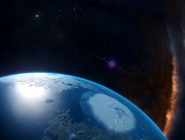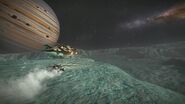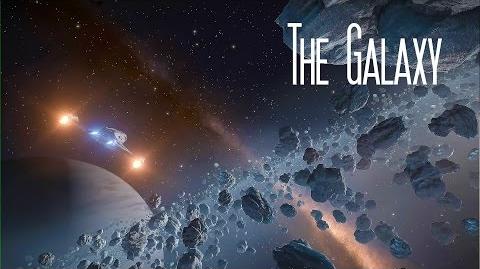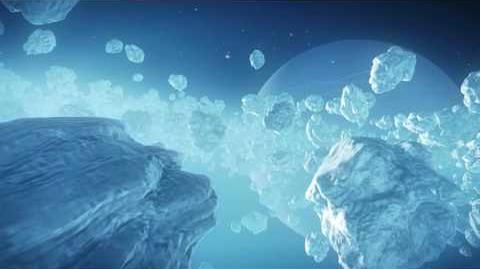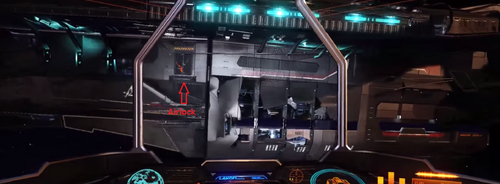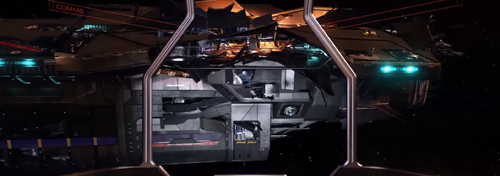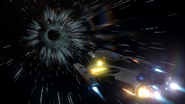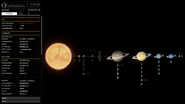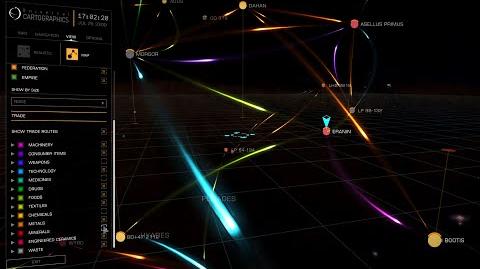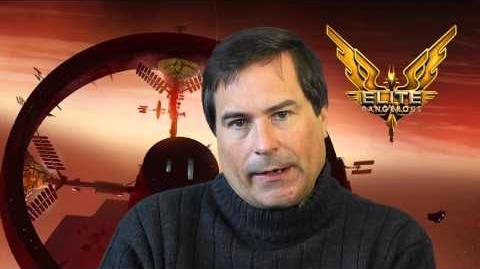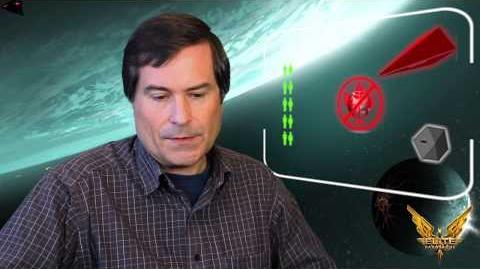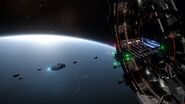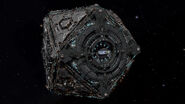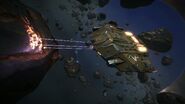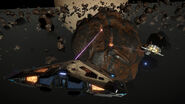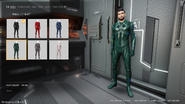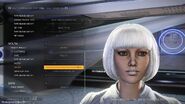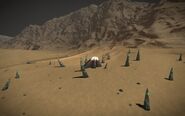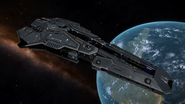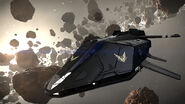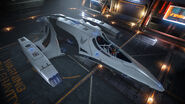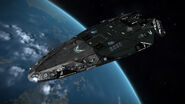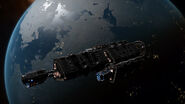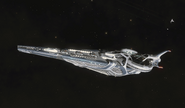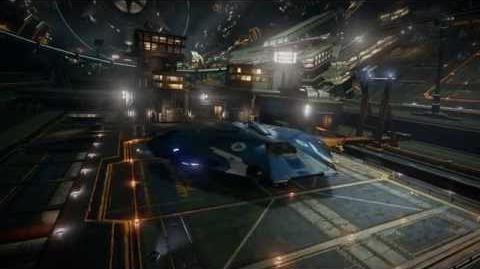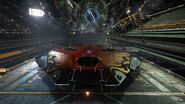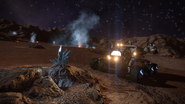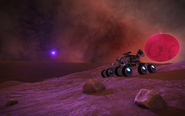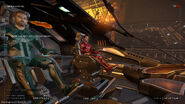 |
Parts of this article have been identified as out of date. Please update this article to reflect the current version of the game, and remove this template when finished.
|
General FAQ
What is Elite Dangerous?
Elite Dangerous is the definitive massively multiplayer space epic. It's the 4th instalment in the legendary Elite series, which includes mass-multiplayer as an integral part, while still allowing online single player. It will also be the first in the series that will be expanded with walking around.
The subtitle "Dangerous" refers to the 3rd best Elite Rating you could achieve during combat in the Elite games. In the new game it has been expanded to include more than combat. The origin of the series is Elite, the genre defining open world sandbox, space adventure, trading and combat simulator first released in 1984. It spawned two sequels Frontier: Elite II in 1993 and Frontier: First Encounters (Elite III) in 1995, which already attempted to simulate a realistic Milky Way galaxy with realistic star systems and seamless freeform interplanetary and atmospheric flight and landing on moving planets, with realistic orbits and day/night cycles. The developers have gone to great lengths to map and electronically recreate the Milky Way to scale to make the game as realistic as possible.
The original Elite (1984) is a true classic and revolutionary at the time and inspired the creation of many space games new game genres and the creation of the "Grand Theft Auto (GTA)" series.
Elite Dangerous is set in the same fictional universe called the Elite Universe. The Elite Dangerous page on this wiki has more information.
Official Pages:
- Official Elite Dangerous website
- Elite Dangerous on YouTube
- Official Forums
- Official FAQ
- Official News & Updates on Facebook
- Elite Dangerous on Twitter
- Elite Dangerous Subreddit
- Elite Dangerous Xbox One Subreddit
- Elite Dangerous PlayStation 4 Subreddit
- Elite Dangerous on Steam
- Elite Dangerous on Wikipedia
- Design Discussion Archive (2014)
- David Braben - reddit AMA (2013)
- David Braben - reddit AMA (May 26, 2016)
- Galnet News - the latest information on in-game events and stories
- Elite Dangerous Role Playing Game
- Frontier Developments
What are the main features of Elite Dangerous?
- An immersive, evolving galaxy with dynamic society, economy and stories, allowing pilots to join each other and together change the story of the Milky Way.
- Free-form play allows everyone to choose their own path, becoming an angry pirate, a spy, a peaceful trader, an explorer, a soldier, or a mix between these roles.
- Player actions can change the narrative and history of humankind. Such as battle [[pirate]]s, participate in community events, leaving a mark in the galaxy.
- There are no classes or skill levels, strength is decided by ship equipment and player skill.
- More than 30 different and customizable ships.
- Surface vehicles such as the Scarab to explore planets and moons.
- The vast, scientifically accurate 1:1 scale of the seamless Milky Way galaxy is created using a mix of procedural generation and artist direction.
- Around 400 billion stars (100 billion star systems) according to current scientific theories of star system formation with planets and moons that orbit and rotate.
- Groundbreaking in that it's based on a lot of hard science with all sorts of star surveys that are fixed and merged to for the first time in gaming history compose a very consistent model of the Milky Way galaxy and it's rich enough to plot the night sky.[1]
- Cosmic phenomena, all different kinds of stars, star systems, black holes, detailed planets, moons, mountains, canyons, craters, planetary ring systems, star rise etc.
- Specially handcrafted overrides for 160,000 known stars in the night sky and planetary objects that we know and love. For example, our solar system Sol with Earth, the Moon and Mars. There are systems with recently discovered planets such as Trappist-1.
- Alien life such as fungal life.
- 141 nebula in the Milky Way galaxy.
- Star Clusters with rich survey data opportunities.
- 32 other galaxies are visible from the Milky Way.
- Several sentient species in the galaxy. The most notable are Humans, Thargoids and Guardians. More species are yet to be discovered.
- The Galactic Plane.
- Flight Model of Elite Dangerous has Newtonian physics with a fly-by-wire layer applied over the top to make the combat feel visceral and seat-of-the-pants, rather than Frontier's jousting at huge distances. Newtonian space combat (ships will continue to move unless intervened but without orbital mechanics)
- Freeform (manual yaw/pitch/roll) interplanetary flight allows to fly freely through star systems in realistic scale to get to a destination. Players can choose to travel wherever they want, including vista points to see Earth rise on the moon, the sun appearing behind Mars, or they could choose to explore the vast expanse of space and discover new points of interest in star systems.
- Multicrew adds the ability to join a seat of another commander's or let others join your ship.
- Holo-Me is the name of the character customization feature for the player's commander. It allows deep character customization.
- Camera Suite is a fully functional third-person camera suite.
- Players can choose between the following game modes: Solo (single player), Private Group (only with friends and invited people) or Open Play (multiplayer, play with everyone).
- The Background Simulation is dynamic, complex and reflects the evolution of the known galaxy with ever changing power and system influence of factions in response to player behavior. Every station has its own demands and supply that change dynamically. Players on different platforms cannot directly play with each other. However, every player on every platform affects the same shared galaxy, star systems, factions and the dynamic background simulation.
- A shared narrative which is influenced by players on all different platforms. This occurs with community events like Salomé, community goals and Powerplay activities. All of the meta data for the galaxy is shared between players. It's not traditional storytelling, rather an interactive, overarching narrative. Players have influenced and changed the course of events. The story unfolds in real time, in which players decide the outcomes and can be the stars. The latest information on in-game events and stories are reported on GalNet. See the Elite Dangerous Timeline for a chronological list of events.
The scope of Elite Dangerous is huge. It will be expanded with ambitious features such as Atmospheric Landings and on-foot and out-of-ship activities also known as Space Legs. Such as FPS combat, walking around and boarding ships, walking in stations and walking and driving vehicles on entire 1:1 scale populated living planets, multi-player crew and player executive controlled capital ships.
More detailed information on a lot of the planned features can be found in the Design Discussion Archive (2014).
What are good videos that show the game?
Here are some carefully selected fan made videos that show various aspects of the game:
On what platforms is and will Elite Dangerous be released?
Elite Dangerous has been released on:
- Microsoft Windows on 16 December 2014. It is currently sold in version 2.0 ("Horizons")
- Apple Mac OS X on 12 May 2015. It is currently sold in version 1.5 ("Season 1")
- Xbox One on 6 October 2015. It is currently sold in version 1.5 ("Season 1")
- Sony PlayStation 4 and PlayStation 4 Pro on 27 June 2017.[2]
And is planned to be released on:
- Xbox One X with 4k resolution support on 7 November 2017.[3]
Where can I buy Elite Dangerous?
Elite Dangerous can be purchased on the Frontier Developments Official Store, Steam, and on Microsoft Store for Xbox One. It's also available in the store for the Oculus Rift.
What are the system requirements to run Elite Dangerous?
While the full release of Elite Dangerous is available on both Windows PC and Apple Mac computers. Everyone who bought Elite Dangerous, will be able to download the game for Windows and/or Mac computers once it is available, at no extra charge.
PC (Minimum System Requirements)[4]
- DirectX 10 hardware GPU with 1GB video RAM
- Quad Core CPU (4 x 2Ghz is a reasonable minimum)
- 4 GB System RAM (more is always better).
- For Elite Dangerous Horizons: 6GB RAM
- Nvidia GTX 260 / ATI 4870HD (DirectX 10 hardware GPU with 1GB video RAM),
- For Elite Dangerous Horizons: Nvidia GTX 470 or AMD R7 240 (Direct X 11 functionality required)
- Internet Connection
- For Elite Dangerous Horizons: Network Broadband Internet Connection
- Hard Drive: 8 GB available space
Recommended PC Requirements for Elite Dangerous Horizons[5]
- OS: Windows 7/8/10 64 bit
- Processor: Intel Core i7-3770K Quad Core CPU or better / AMD FX 4350 Quad Core CPU or better
- Memory: 8GB RAM
- Graphics: Nvidia GTX 770 / AMD Radeon R9 280X or better
- Network Broadband Internet Connection
- Hard Drive: 8 GB available space
Recommended PC VR System Requirements:[6]
- OS: Windows 7/8/10 64 bit
- Processor: Intel Core i7-3770K Quad Core CPU or better / AMD FX 4350 Quad Core CPU or better
- Memory: 16GB RAM
- Graphics: Nvidia GTX 980 with 4GB or better
- Network Broadband Internet Connection
- Hard Drive: 8 GB available space
Mac OS X (Minimum System Requirements)[7]
- 2.3Ghz quad-core Intel Core i5 CPU
- 4GB System RAM
- NVIDIA GT 650M 1GB or equivalent (found in Early 2013, Macbook Pro Retina 15")
- Internet Connection
- A non case-sensitive file system
- Mac OS X 10.11.x "El Capitan" (10.10.03 or higher recommended), Latest version of Mono (will be installed on first run of the launcher)
Are there plans for other platforms to be supported?
Frontier Developments have confirmed that the game will be released as a timed-exclusive on Xbox One in the Summer of 2015 and a PlayStation 4 release on June 27, 2017. There might be a Linux desktop version. The initial release was Windows only with Mac OS X planned a few months later.
Does Elite Dangerous support Physically Based Rendering (PBR)?
Yes according to an interview with a graphics programmer dated August-29-2013.
My specialism for this project has mostly been full-scene things, like updating our lighting model to a “physically based” system.
And according to the executive producer.
Short answer: yes it does.
Elite Dangerous adopted a physically-based rendering (PBR) model right from the start - we want it to look as good as possible under a variety of lighting conditions (and space certainly gives you that!). We expect the visual quality of Elite Dangerous will continue to improve as we progress through development.
It's worth mentioning though that PBR isn't a one-size-fits-all solution as much as it's the start of a discussion that could probably occupy someone for their entire career - kind of like the way "High Dynamic Range" was quickly adopted by everyone years ago but people are still arguing over the fine details!
Does Elite Dangerous have positional damage?
Yes, the modules all have a position in or on the ship, and some calculations are done based on your armour to decide if there's any penetration at all (which gets more likely as your armour gets beaten up), then how far it's likely to penetrate and which modules are along the path of that penetration and might take damage (there's several more subtle rules, but that's the broad strokes).
Damage is also visually represented.
How can we travel those vast distances in such a huge galaxy?
There are two modes of super luminal (faster than light) travel to cover those vast 1:1 scale distances.
- Supercruise, formerly known as frame shifting, is used for freeform (manual pitch/yaw/roll) travel within star systems. The maximum speed varies based on proximity to celestial bodies, up to 2001 times the speed of light (2001C) that rarely gets reached, to be able handle the most extreme spatial distances. It consumes a small amount of fuel and you can also see other ships that are super-cruising within a star system from a long distance away visually and with long range sensors and also do combat manoeuvring to perform interdictions.
- Hyperspace drives are used to travel from anywhere between star systems. Hyperdrives with different ranges, charge up times and fuel consumption parameters are available, and so your particular model of hyperdrive governs your specific ability to move around the galaxy. The game ensures that you will get grouped with other ships near the star with the largest mass during hyperspace exit.
How are players going to meet each other in such a huge galaxy?
You can use the Galaxy Map to navigate through the Milky Way galaxy. The System Map displays a system's layout and information. Most of the action will take place within the human populated core systems of the major factions. This region is known as The Bubble. It's where powers compete for influence, resources, territory and control. Powerplay is an ongoing battle for interstellar conquest and control in the galaxy.
Due to the way interstellar hyperspace travel works, the game will ensure that you will get grouped with other ships near the star with the largest mass during hyperspace exit. You will also be able to find other ships that are super-cruising within a star system from a long distance away visually and with long range sensors. There will also be ways to follow each other's hyperspace trail.
Multicrew is a feature introduced in 2.3. Multicrew adds the ability to join a seat of another commander's ship or let others join your ship, which can be done by being in a Wing. You can only have up to 3 people in a ship which has enough seats. A crew of 3 people in a Multicrew set-up performs similarly to a wing of 3 ships.
Players won't be able to just take off and disappear into uncharted areas of the galaxy without a huge amount of preparation and logistical equipment, and even when they do start doing that, a big reason for exploring is to find rich systems with lots of resources, so you can make more money by trading or selling information about the location of the resources, which leads them back to the core systems yet again. And if new interesting places with rich resources are found, then one of the major factions may claim the system leading to it becoming part of the core and space stations being built in those systems. But of course, you can also just go sightseeing.
Having such a large quantity of star systems permits the game to have many major discoveries and many more minor ones, enough for hundreds of thousands of players to experience the opportunity of unique finds without the feeling of tripping over the Ark of the Covenant every two minutes.
Is there an extensive dynamic economy?
Yes, Elite: Dangerous involves a dynamic Background Simulation, reflecting the evolution of the known galaxy with ever changing power and system influence of factions in response to player behaviour. Every station has its own demands and supply that dynamically change.
Elite: Dangerous features a complex background simulation which drives a dynamic system of ever changing power and influence. Struggles between minor factions are commonplace throughout the galaxy and are led by the actions of player commanders both inadvertently and intentionally through the mission system and other activities. Many players enjoy actively supporting a chosen faction indefinitely; helping to win their battles, defending territory and expanding the faction's operations into nearby star systems - ultimately building a small empire in their chosen sector of space. Playing the game this way offers an almost strategic, board game like experience and it can be immensely satisfying when your goals and objectives are met. Player actions can turn a small faction into an interstellar operation. It is important to note that while altering the local politics of a star system can be done by a lone commander, it will be far easier in groups of people all working towards a common goal, particularly as the faction grows. Where there is unity, there is victory. [8]
- Faction Warfare: How the Galaxy will Evolve Over Time - Dev Diary
- Dynamic Economy: Trading - Dev Diary
- Faction System with Dynamic Society, Economy, Events and Stories
- Newsletter about Trading and Economy
- Background Simulation and Economy (2013)
- Trading (2013)
- Faction Causes and Dynamic Story Generation (2013)
- Design Discussion Archive (2014)
Are there any missions or quests?
Yes, missions fall into several types, the ones that you find en route and the ones that will have you actively engage in through a contract. These can earn you both credits and status within the faction you are working for, whether it is a disreputable criminal group or the Federation or Empire themselves.
- Role Playing Elements
- Faction System with Dynamic Society, Economy, Events and Stories
- Ratings and Reputations (2013)
- Persistent NPC's (2013)
- Contacts (2013)
- Criminality (2013)
- Bounty Hunting (2013)
- Trading (2013)
- Passengers (2013)
- Slaves (2013)
- Mining (2013)
- Exploring (2013)
- Salvaging (2014)
- Fuel (2014)
- Design Discussion Archive (2014)
Are there any roleplaying elements?
Just like in all the previous Elite games, you are not fixed to a specific role like in a traditional roleplaying game, there are also no skillpoints that directly affect the way your avatar performs. Instead you will always be directly in control of your avatar so your own skill will determine the outcome of your interactions.

Elite Dangerous CargoHatch Disruptor
That said there are extensive ratings and reputation systems that affect how NPC's and players perceive you, even going so far as taking ship appearance (age/damage) into consideration. There is also an extensive customization option for the ships. You can change your character's appearance at any time with the [Holo-Me].
- Wings
- Multicrew
- Missions
- Faction System with Dynamic Society, Economy, Events and Stories
- Ratings and Reputations (2013)
- Persistent NPC's (2013)
- Contacts (2013)
- Criminality (2013)
- Death Penalty (2013)
- Bounty Hunting (2013)
- Communication (2013)
- Trading (2013)
- Passengers (2013)
- Slaves (2013)
- Mining (2013)
- Exploring (2013)
- Salvaging (2014)
- Fuel (2014
- Design Discussion Archive(2014)
Will I be able to smuggle illegal goods?
Yes
Is there any mining?
Yes, just like the last two Elite games, there is mining. First Mineral Bodies (Asteroids), Frozen Liquid Bodies (Comets), Gas/Dust Clouds and Salvaging, but planetary mining machines are to come.
Is Elite Dangerous Groundbreaking?
Yes, it's groundbreaking in that the galaxy is based on a lot of hard science with all sorts of star surveys that are fixed and merged to, for the first time in gaming history, compose a very consistent model of the Milky Way galaxy and it's rich enough to plot the night sky.[9] It's also one of the first major titles to offer full virtual reality support with an exceptionally immersive experience in an all-encompassing universe, and every player on every platform affects the same shared galaxy with an interactive overarching narrative via the background simulation.
I heard that the Elite series has no actual storyline. Is that true?
No. Elite Dangerous features a shared narrative which is influenced by players on all different platforms. This occurs with community events like Salomé, community goals and Powerplay activities. All of the meta data for the galaxy is shared between players. It's not traditional storytelling, rather an interactive, overarching narrative. Players have influenced and changed the course of events. The story unfolds in real time, in which players decide the outcomes and can be the stars. The latest information on in-game events and stories are reported on GalNet. See the Elite Dangerous Timeline for a chronological list of events.
While the original Elite and Frontier: Elite 2 didn't have an in-game story, the 3rd Elite game, Frontier: First Encounters did have an in-game storyline centered around the Thargoids alien encounter that you could follow if you chose to do so. The story wasn't explicitly told with traditional cut-scenes, but unfolded from a first person perspective with the help of news events and corresponding missions. Elite: Dangerous continues with that style of storytelling and is set 45 years after the events of Frontier: First Encounters, in the year 3300 and the Thargoids will make a return. It features more dynamic events, available from newsfeeds within the game or outside, based on both developer injected, dynamic procedural stories , player-caused events and missions. The game will also have more than 13 official book tie-ins to tell different stories about Elite universe, with lots of places, events and people referenced in the game.
- Galnet Archive (Elite: Dangerous newsfeed archive)
- Elite Fiction Diaries
- Elite timeline from the older games 1950-3255 (will be revised)
- Missions/Quests
- Role Playing Elements
- Elite Fiction Forum
- Explanation on how in-game storytelling in Elite: Dangerous works
- Faction Warfare: How the Galaxy will Evolve Over Time - Dev Diary
- Newsfeeds
- Faction Causes and Dynamic Story Generation
- Dynamic Economy: Trading - Dev Diary
- Factions and Elite Federation
- Newsletter about Trading and Economy
- Background Simulation and Economy
- Trading
- Injected Events
In addition to this the Elite universe does have an extensive background history which is covered in many different sources, like In the official novellas - The Dark Wheel from Elite, Stories of Life on the Frontier Life On The Frontier and The Gazetteer from Frontier: Elite 2, and Further Stories of Life on the Frontier from Frontier: First Encounters which can all be found in the following links [1] [2] [3] . In addition to this there is also Fan Fiction.
Is there detailed ship management and avionics?
Yes, see the following links:
- Ship Damage
- Ship Systems with Heat Management and Stealth
- Sensors and Targeting
- Frame Shift Drive and Long Range Sensors
- Shields
- Mining
- Fuel
- Interview explaining Sound HUD
- Design Discussion Archive
- Dev Diary about cockpits and HUD
Will I be able to hire crew for my ship?
Yes, as with previous Elite games you will be able to hire NPC crews and player crews for the larger multi-crew ships in future updates.
Can I hire wingmen?
You can hire NPC crew who can pilot your ship and ship launched fightershire wingmen and escorts, but you won't be able to own them. They take a percentage of your profits as payment for their services. Their loyalty will depend on their morality and faction connections, so they will be able to betray you, or simply refuse to engage in certain criminal acts. You can hire other players to join your wing.
Will it be possible to manually land on planets?
Yes, just like the previous two Elite games you will be able to seamlessly freeform (manual pitch/yaw/roll) enter and fly through entire 1:1 scale planets. Populated planets with Atmospheric Landings and living cities and wildlife enabling extra-vehicular activities will be added with major updates and expansions.
The scope for Elite is huge, so a sensible strategy is used to add to the game in stages.
- Keep in mind that the game has been well planned and designed from the start with all these features in mind (it is not an afterthought) and Frontier Developments already has the technology for this.
- Elite: Dangerous - Development Plan video
- Q&A about Development Plan
- Newsletter about Landing on Planets, Ship interiors and Walking around
Will landing and docking be seamless in Elite Dangerous?
Yes, just like in all the previous Elite games you are able to manually dock with space stations seamlessly. Future expansions will also add the possibility to seamlessly freeform land on planets. Landing and docking will be doable either using auto pilot, or manually.
- Newsletter about Space Stations
- Newsletter about Space Station Docking
- Space Station Docking Proposal
- Development Plan
Will gas giants be realistically represented?
- Yes, there are gassy and cloudy gas giants.
Can I walk around the ship, planets and space stations?
Space Legs refers to gameplay where players can walk around with extravehicular activity (EVA). This is a highly anticipated feature. It's unclear when space legs will be added to Elite Dangerous. Horizons was ruled out, so many people hope it will come during season 3. Multicrew and Holo-Me form the foundation for space legs features.
It's always been a core vision of David Braben that the player is a person in a real futuristic setting, not just a ship. In 2016, Braben confirmed that Frontier is working on walking about features "Yes. We have ongoing work on planets, including atmospheres, planetary life, walking about and lots of other very exciting things for the future."[10]
You will be able to walk around the ship interiors, operate ships with multiple players, board and steal other ships with Zero-G FPS combat, walk around and do FPS combat in space stations, do space walks to repair your ship, operate land and underwater vehicles and walk on entire 1:1 scale populated planets with NPCs in living cities, forests and be able to big-game hunt wildlife, like chasing big dinosaurs around as part of expansions.
The scope for Elite is huge, so a sensible strategy is used to add to the game in stages. Keep in mind that the game has been well planned and designed from the start with all these features in mind (it is not an afterthought). See this Planet Coaster - Dev Diary for a glimpse of the technology that Frontier Developments have for this.
- Elite: Dangerous - Development Plan video
- Q&A about Development Plan
- Newsletter about Landing on Planets, Ship interiors and Walking around
- Newsletter about Space suits, walking around ships and zero-G FPS combat
- The Fiercest Creature on Altair - An example of big-game hunting dinosaur-like wildlife in prior Elite lore
- Dev Diary about cockpits, avatars and HUD
- The Future of Elite Dangerous
How big are planets and star systems?
Elite: Dangerous has a scientifically accurate 1:1 scale, fully seamless Milky Way galaxy, created from scientific first principles where stars and planets will be accurately positioned relative to your view. And just like the last two Elite games the planets and stars are on a 1:1 scale realistically sized with vast distances between them. The detail in Elite ranges from the macroscopic to microscopic scale.
- The Video Game That Maps the Galaxy : The New Yorker
- Newsletter about the star system generation process
- Newsletter about getting rid of the skydome
- Newsletter about the Galaxy Map
- David Braben talking about the scale of the star systems
- About the benefits of using a custom engine to solve the 1:1 scale challenge
Do planets rotate and orbit around stars?
Yes, just like in the last two Elite games, Frontier: Elite 2 and Frontier: First Encounters (Elite 3), planets and moons orbits and rotates in 1:1 scale real-time and tilt will affect their seasons. Full orbital periods are noticeable in-game.
Can I create my own Character?
Yes, Holo-Me is the name of the character customization feature for the player's commander. It allows deep character customization. For example, players can change their suit, many head and facial features, gender and other cosmetics. Players can customize their character at any time. Holo-Me requires the Elite Dangerous: Horizons expansion.
Are there alien life forms?
Alien life is common, but sentient alien life is rare. There are three known sentient species: Humans, Guardians and Thargoids. The Thargoids are a mysterious insectoid species which appeared in the original Elite and had an extensive story arc in Frontier: First Encounters (Elite 3) and they will make a return in Elite: Dangerous. The Guardians are an extinct alien humanoid species. There's other kinds of alien life such as Fungal Life.
How many ships are flyable by players in Elite Dangerous?
There are 33 flyable ships and there are plans for more ships with major updates. Both new, modified, and improved models from the previous Elite games.
Can I own multiple ships?
Yes, there is no limit to the amount of ships you can own, but you can only fly one at a time.
Can I own and control capital ships?
There are capital ships in the game, but initially you won't be able to control or own them. There will be player controlled capital ships in a future expansion or major update. Megaships can be owned by player factions.
In The Commanders Livestream, a viewer asked "any chance of playing capital ships in the future?", David Braben answered: "it's on the list, but a long way down it, because there's a lot of gameplay to make it work. The issue is what we call the difference between direct control and executive control. Where rather than flying by the seat of your pants you're giving orders to a giant ship. Because you can't expect it to change course very rapidly and that sort of thing. So it's certainly a long-term possibility, but it's long-term."[11]
You can own and fly large multi-crew ships like the Anaconda and soon to come, the Panther Clipper and Beluga Liner. Some ships, like the Anaconda, can carry smaller ships, so you’d be able to launch a small fighter from it, which is more nimble.
Can I build an empire and own space stations and fleets?
You will be able to own small inflatable asteroid stations as depicted here as part of an update, but you can't fully own large stations, build empires or own fleets, since that would change the nature of the game. However, David Braben stated that they will add this type of functionality to some degree in the future.
Question: "Will it be possible to own a fleet of ships, staffed by NPCs and given orders to follow so that they trade or scout or mine ore etc?" David Braben answered: "With time we will add this sort of functionality to some degree, but we don't want it to be the be all, end all of the game."[12]
For example, why would you pilot space ships yourself, when the most efficient way to make money and progress in a game is to sit back in an office and hand out commands? It's also problematic from a lore and immersion standpoint, since the game is simulating realistic societies, social structures and time scales, so building an empire would involve a lot of resources and politics that only big nations can afford and would stretch over months or years, even building a large space station can take a month or more.
So as an Elite federation pilot, you will initially only be able to aid in building empires and large space stations through Community Goals, by taking missions to transport resources and defend them, but you are too low on the social ladder (not important enough) to be able to command or own these kind of things. When they add this type of features to "some degree" it would need to strike a balance between realism and gameplay.
That said, you will be able to hire NPC wingmen and escorts and give them simple commands, but you won't be able to own or remote control them directly.
Why are the ships simpler in design compared to other games?
Because Elite: Dangerous is set in a realistic galaxy where there is no anti-gravity or gravity generators. Atmospheric capable ships are engineered to be symmetrical and aerodynamically streamlined, therefore they carry their weapons inboard within a bay to be able to believably skim, enter and freeform (manual pitch/yaw/roll) fly through planet atmospheres at hypersonic speeds. Many ships are based on the iconic wireframe designs of the original Elite.
- The ships in Elite: Dangerous have airlocks, proper mass distribution with no off-centre main thrusters and separate tessellated cargo holds.
- However, just like the ships in the previous Elite games, there will be a lot of variety in designs with each manufacturer having its own unique style, which can customized into numerous configurations.
Can I use other Vehicles?
Yes, there is a surface vehicle called the Scarab. It's a Surface Recon Vehicle that allows pilots to drive around planetary surfaces in the Horizons expansion. Combat-wise it is outfitted with a shield and a plasma repeater turret. Additional vehicles are planned for future updates.
Can I make Cinematic Videos?
Yes, the Camera Suite is a fully functional third-person camera suite. It lets players take sophisticated screenshots, make cinematic videos and fly ships in third person. It succeeds the old Debug Camera and is part of update 2.3 The Commanders. In the revamped version you can move around much quicker and further away from your ship. There's a UI legend of shortcuts which can be hidden, and it features a zoom slider. You can lock the camera to your ship and are able to control the ship in a third-person perspective. The camera can ignore rotation so it has the same orientation.
How do I play Elite Dangerous?
Please check the Pilots Guide on this wiki. It is designed to help a new or experienced pilot get the most out of their spacecraft.
It is recommended that you check out the following guides:
- Elite: Dangerous Pilot Training Tutorials
- Elite Dangerous: Horizons Training Guides
- Official quickstart manual
- Official comprehensive manual
- EXO Pilot's Manual
- The Guide for Almost Everything
- Forger's detailed pilot's guide
- Technophebe's new pilot's guide
Why is yaw so slow?
There is an inherent flaw with the premise of close combat space flight, leading to endless turreting and circle-strafing especially in PVP multiplayer, due to the lack of terrain features in mid space, compound that with the fact that Elite also features lightspeed pulse and beam lasers making this issue even more apparent. A fly-by-wire layer is applied on top of the Newtonian physics and it limits the yaw speed.
Elite: Dangerous deals with this by limiting the yaw rate and enforce an optimum corner speed by way of thruster placement and limits in the flight control computer, forcing to roll and then pitch to get the most efficient turn rate (less efficient, but most comfortable for a human pilot), in addition there is a G-LOC system, a preliminary version can be seen here.
Are there Newtonian physics?
Yes, the flight model of Elite Dangerous has Newtonian physics with a fly-by-wire layer applied over the top to make the combat feel visceral and seat-of-the-pants, rather than Frontier's jousting at huge distances.
Just like in the last two Elite games, the flight physics are Newtonian[4]. While this time the forces are fed to a proper rigid body, (so rotation is properly taken into account) instead of a simple point mass (where only linear dynamics matters), the fly-by-wire system (flight control computer) in Elite: Dangerous constrains the ship's angular and linear velocity relative to a common reference frame during regular local flight, to induce interesting tactical dogfights at close range and this flight assist can be partially disabled to be able to skid more freely. Also unlike the last two Elite games, only the Super-Cruise mode (Work In Progress) takes planet interaction into account (subject to change).
Here some quotes from the creator David Braben:
"David Braben I think in many respects it's more comparable to Frontier in terms of the way the galaxy works, that sort of thing. But in terms of the way you fly it's much closer to Elite. We're going to have Newtonian physics. But the way that we apply the fly-by-wire layer over the top of makes the combat feel really visceral and seat-of-the-pants, rather than [as in Frontier] jousting at huge distances"[5]
"David Braben Most of the ‘brutal realism’ of Frontier will continue. The real galaxy and so on. For the combat model we are doing more fly-by-wire than in Frontier, but this is to improve the feel of the game; the realism is still there. Don’t forget there was fly-by-wire in Frontier too."[6]
So there is a fly-by-wire system that keeps the ship within flight parameters, with a flight assist mode that is on by default, that helps you maintain your turns and dampen the angular momentum when rolling, pitching and yawing by automatically calculating the thruster forces needed to stabilize the ship and reduce the skidding. You can turn flight assist off, so you will have have to manually adjust the thruster forces to control the skidding and counteract the angular momentum, the fly-by-wire however will always be partially active to keep your ship constrained within the specified limits. Cargo mass will also affect the manoeuvrability of your ship.
Can I manually fire thrusters in every direction?
Yes the game allows for full 6DOF motion.
Is Elite Dangerous an MMO?
Yes, Elite Dangerous is an MMO, but with the important addition, that you can choose if you want to meet other players.
Players can choose between the following game modes: Solo (single player), Private Group (only with friends and invited people) or Open Play (multiplayer, play with everyone). In open play, you may encounter any other player who is also in Open, instancing and matching players occurs via a complex system. Players on different platforms cannot directly play with each other. However, every player on every platform affects the same shared galaxy, star systems, factions and the dynamic Background Simulation.
The game features a shared persistent galaxy, where macro effects and events such as economy, society and war status etc. are recorded and shared across all the different platforms. So all players influence the same shared galaxy.
The are no multi-player lobbies. The server transparently creates free roaming sessions (instances) when meeting other players and NPCs within that galaxy based on a perception bubble around you, that is defined by your scanner/visual range. That means that those instances are not a fixed location in space as in most other MMOs, but they dynamically move around.
The effects of those instances are then stored on the central galaxy server and shared by everybody.
Because the game features very high speed twitch combat and very detailed damage models, this is the most reliable way to do it, also keep in mind there can be many sessions within a star system and those sessions can dynamically move around, also because this game uses a 1:1 scale Milky Way galaxy, sessions will typically be spread out much further away (although most of the action will be within the core systems) and it wouldn't be immersion breaking as opposed to a space game in a smaller area.
- How are players going to meet each other in such a huge galaxy?
- Multi-player Groups
- Death Penalty
- Design Discussion Archive
How does singleplayer work? Will I need to connect to a server to play?
Yes. The online galaxy of Elite Dangerous is a shared universe maintained by a central server. All of the meta data for the galaxy is shared between players. This includes the galaxy itself as well as transient information like economies. The aim here is that a player's actions will influence the development of the galaxy, without necessarily having to play multiplayer.
The other important aspect for the developers is that they can seed the galaxy with events, often these events will be triggered by player actions. With a living breathing galaxy players can discover new and interesting things long after they have started playing.
Does Elite Dangerous have a monthly subscription fee?
No. Elite: Dangerous has a fixed box price, without hidden costs. However, you will pay one-time fees for major additional expansions.
What are the expansions?
The expansions include significant new features such as seamless freeform (manual pitch/yaw/roll) atmospheric flight and landings (Atmospheric Landings) and on-foot and out-of-ship activities (Space Legs). For example FPS combat, walking around and boarding ships, walking in stations and walking and driving vehicles on entire 1:1 scale populated living planets. Also multi-player crew and player executive controlled capital ships.
Frontier releases free updates roughly each month that enhance the game. Expansions that include significant new features and content will have to be purchased.
For example, the roadmap is to add these features over the following expansions (in no particular order): [7]
- Landing / driving / prospecting on airless rocky planets, moons & asteroids (Elite Dangerous: Horizons)
- Walking around interiors and combative boarding of other ships - see the Space Legs page.
- Combat and other interactions with other players and AIs in the internal areas of star ports
- Accessing richly detailed planetary surfaces - see the Atmospheric Landings page.
- Availability of giant ‘executive control’ ships to players - see the Capital Ships page.
- The scope for Elite is huge, so a sensible strategy is used to add to the game in stages.
Keep in mind that the game has been well planned and designed from the start with all these features in mind (it is not an afterthought) and Frontier Developments already has the technology for this.
- The Future of Elite: Dangerous
- Elite: Dangerous - Development Plan video
- Q&A about Development Plan
- Newsletter about Landing on Planets, Ship interiors and Walking around
What are the Future Development Plans?
Elite Dangerous has a truly huge scope and Frontier has ambitious development plans. During an interview at Lavecon 2015, Frontier stated to have a clear intention of a 10 year development plan. [13] This includes small free updates and paid major updates. Frontier uses an iterative approach which means gradually build upon features to expand and improve them. Check the Features in the Expansions page for a rough overview of planned additions for ED.
Does Elite Dangerous support Virtual Reality Gaming?
Yes, Elite Dangerous is a groundbreaking title for virtual reality gaming, because its one of the first major titles to offer full VR support with an exceptionally immersive experience in an all-encompassing universe. It was the go to game for many VR headset demos before the devices were commercially available. From a technical standpoint, Elite Dangerous is one of the PC’s most high-end VR titles, pushing even very powerful PCs to their limit.
Elite Dangerous is designed from the ground up to support Virtual Reality and 4K Ultra HD display technology. It has Cutting-edge visual quality and performance enabled by Frontier's COBRA engine. It supports the latest displays at 4K resolution, and is built for the future with full 8K and 16K support. It's compatible with Oculus Rift, SteamVR and Vive headsets.[14]
What are the official websites and fansites about Elite Dangerous?
Check the Fansites page for an elaborate overview of official websites and fansites.
Differences with Other Space Games
What are differences between Elite Dangerous and Star Citizen?
The differences are predominantly in issues surrounding scale, complexity of background simulations, adherence to recognized science of the universe and release schedule.
Heritage:
Elite Dangerous is the 4th instalment in the legendary Elite series dating back to 1984.
Star Citizen has some commonality with other games like Wing Commander / Privateer / Starlancer / Freelancer series dating back to 1990. However, it's a new and separate franchise. It's not a continuation of those previous games.
Release Schedule:
Elite Dangerous was released on December 16, 2014 and has received many major updates and expansions since then.
Star Citizen is projected for a general release in late 2016. However, it has been postponed many times. In mid 2017 it's not a full-game yet.
Story:
Elite Dangerous has and Star Citizen will have an on-going background story which will be influenced by the players and augmented with developer injected events. Elite Dangerous takes place much further into the future (34th century). As such the technology is more advanced with a more futuristic science fiction setting. The universe of Elite is generally grittier and more realistic in the sense that there are no clear Hollywood style good and bad guys.
Star Citizen comes with a single-player focused cinematic scripted campaign called Squadron 42 and is projected for general episodic releases starting from late 2016, followed by two DLC sequels in the future
Ship Design and landing on planets:
In Elite Dangerous, the ships are relatively larger for their class, and atmospheric capable ones are modeled to be aerodynamically streamlined and symmetrical, and therefore carry their weapons within a bay. This provides ships with hulls that are able to enter and freeform (manual pitch/yaw/roll) fly through planet atmospheres at hypersonic speeds. Capital ships are in the 2 km range
In Star Citizen the ships are less aerodynamically streamlined and carry their weapons outboard, some are asymmetrical. Players can own capital ships up to 345m in length, and can persistently capture & control ships up to 1KM in length The largest ship in the game is 3KM long
- Landing on populated planets in Star Citizen will use virtually guided paths to point you to a dedicated landing zone. Unpopulated planets, or planets with no landing zone, will allow for freeform flight and unrestricted landing.
Methods of Travel:
Elite Dangerous has freeform (manual pitch/yaw/roll) interplanetary fast travel; aka Super Cruise. Due to the realistic 1:1 scale galaxy with proper distances, it necessitates faster than light speeds, specifically up to 2001 times the speed of light (2001c). These high speeds make travel times practical with very long range sensors and combat interaction. Players are able to seamlessly enter hyperspace to travel from anywhere in a system to another star.
Star Citizen's interplanetary fast travel - Quantum Drive - allows for speeds up to 0.2c (20% the speed of light) across a solar system. This limit is for realism reasons, as there is no lore explanation for radiation shielding beyond 0.25c. Due to this, distances between planets are scaled down in order to make travel times practical. QDrive allows for freeform travel within a solar system, althoughonly in a straight line. Travel between solar systems requires wormhole-like jump points (which will allow some interactivity) at fixed locations
Galaxy:
In Elite Dangerous the galaxy is scientifically accurate and includes around a 100 billion star systems (around 400 billion stars considering most systems contain multiple stars). The Elite Universe is modeled on current galactic charts. Planets and moons will rotate and orbit in 1:1 scale real-time, therefore constantly changing a system's environment. As such Elite Dangerous is more hard science fiction than Star Citizen.
Star Citizen's galaxy will have 120 star systems at launch, and an unknown number of explorable, procedurally generated systems. Time is compressed to 2 hours for each day (1:12 scale time). Due to QDrive speed limits, distances between planets are scaled down to around 1/100th scale. Gravity & Orbits will be simulated where practical.
Weapons:
Elite Dangerous has lightspeed pulse and beam lasers on all ships fitted with energy weapons, along with missiles, railguns, cannons, and other weapon types
Star Citizen has a mix of slow-firing lasers (akin to Star Wars), missiles, gatling guns, railguns and ballistic weapons available
Anti-Gravity:
In Elite Dangerous there is no anti-gravityor gravity generators, so space stations are designed to rotate In Star Citizen, space stations and ships use artificial gravity.
Flight and Combat Models:
The flight model of Elite Dangerous has Newtonian physics with a fly-by-wire layer applied over the top to make the combat feel visceral and seat-of-the-pants, rather than Frontier's jousting at huge distances.[15]
There are major differences in how each game handles close combat flight (as you can see from this video). There is an inherent flaw with the premise of close combat space flight, leading to endless turreting and circle-strafing especially in PVP multiplayer due to the lack of terrain features in mid space, compound that with the fact that Elite also features lightspeed pulse and beam lasers making this issue even more apparent.
Elite Dangerous deals with this by limiting the yaw rate and enforce an optimum corner speed by way of thruster placement and limits in the flight control computer, forcing to roll and then pitch to get the most efficient turn rate, in addition there is a G-LOC system, a preliminary version can be seen here.
In Star Citizen ships can be pointed more intuitively in a fashion akin to FPS, requiring a strong yaw. It deals with turreting by having a G-LOC system as seen here, but this alone doesn't alleviate the problems completely, and it's up to the pilot's skill to deal with it correctly. Star Citizen features a fully simulated IFCS that translates pilot input to thruster/gyro activation on the ship.
Multiplayer:
Multiplayer is handled with a grouping system in Elite Dangerous and a PVP-PVE slider which doesn't completely control engagements in Star Citizen. [sentence needs clarification]
Additional Links:
- Star Citizen vs. Elite: Dangerous - Flight Model Comparison
- Dev Diary about cockpits, avatars and HUD
What are differences between Elite Dangerous and EVE Online?
Elite Dangerous is pay once and play, therefore does not have a periodic subscription like EVE Online. Although Elite: Dangerous does offer paid "season passes" these behave more like paid DLC and the more traditional major expansion pack, in that not purchasing them does not prevent the base game from being played, whereas failure to pay for a periodic subscription prevents the base game from being played.
Another major difference is that in EVE everybody within a star system is in one big instance and when there are too many people within it they slow down the update rate of the game.
Elite Dangerous features dynamically created free roaming multiplayer instances, based on perception bubble, that are decoupled from the star systems themselves (but you can also play solo).
Due to a lot less network traffic, this allows Elite Dangerous to have twitch based action instead of classic MMO click 'n' roll (where actual world updates are comparatively slow depending on server load and all attacks are calculated on servers using modified D&D system) which is used in EVE. That means that Elite Dangerous combat is twitch skill based.
An important difference is that EVE's economy is totally player driven - so to have ships and weapons in the game have to be manufactured by players themselves, by collecting resources and providing them to factories. Elite Dangerous uses an economic model that drives NPCs to simulate the flow of products, which also have all player trades as input to the shared universe.
Another important difference is that EVE has a lot of empire building and RTS elements, while Elite is what it would be like to be a spacefarer in a galaxy from a first person’s perspective. PVP also has some differences.
The Elite Dangerous galaxy is based on the real Milky Way planets will rotate and orbit their stars, thus constantly changing a system's landscape and adding lot of depth - and it has around 400 billion stars (100 billion star systems), as opposed to EVE where the planets are static and don't move.
Elite Dangerous has freeform (manual pitch/yaw/roll) interplanetary fast travel up to 2000 times the speed of light (2000C) and you are able to seamlessly enter from anywhere to another star. EVE on the other hand has point & click travel and you must fly to a jump gate to enter another star system.
A major feature that Elite Dangerous will have is freeform (manual pitch/yaw/roll) atmospheric flight and seamless landing on planets and walking on living planets with cities and wildlife also known as Atmospheric Landings, as part of expansions.
References
- ↑ https://www.youtube.com/watch?v=rOYhoFYIWmw
- ↑ https://blog.us.playstation.com/2017/05/16/elite-dangerous-touches-down-on-ps4-june-27/
- ↑ http://www.eurogamer.net/articles/2017-06-13-elite-dangerous-will-get-4k-patch-for-xbox-one-x-launch
- ↑ https://support.frontier.co.uk/kb/faq.php?id=74
- ↑ https://support.frontier.co.uk/kb/faq.php?id=227
- ↑ https://www.elitedangerous.com/en/made-for-vr/
- ↑ https://support.frontier.co.uk/kb/faq.php?id=85
- ↑ http://8thdragonsquadron.com/wp-content/uploads/2016/11/BGS-Guide.pdf
- ↑ https://www.youtube.com/watch?v=rOYhoFYIWmw
- ↑ Ask Him Anything: David Braben, co-creator of Elite, co-founder of the Raspberry Pi Foundation, and Frontier's head honcho
- ↑ Elite Dangerous 2.3 - The Commanders Release Livestream
- ↑ https://www.youtube.com/watch?v=h-bEn2aLJ7U&t=0s
- ↑ https://forums.frontier.co.uk/showthread.php/165775-Lavecon-News
- ↑ https://www.elitedangerous.com/en/made-for-vr/
- ↑ Elite: Dangerous will have 100 billion star systems, plus Thargoids — Braben reveals what's next







